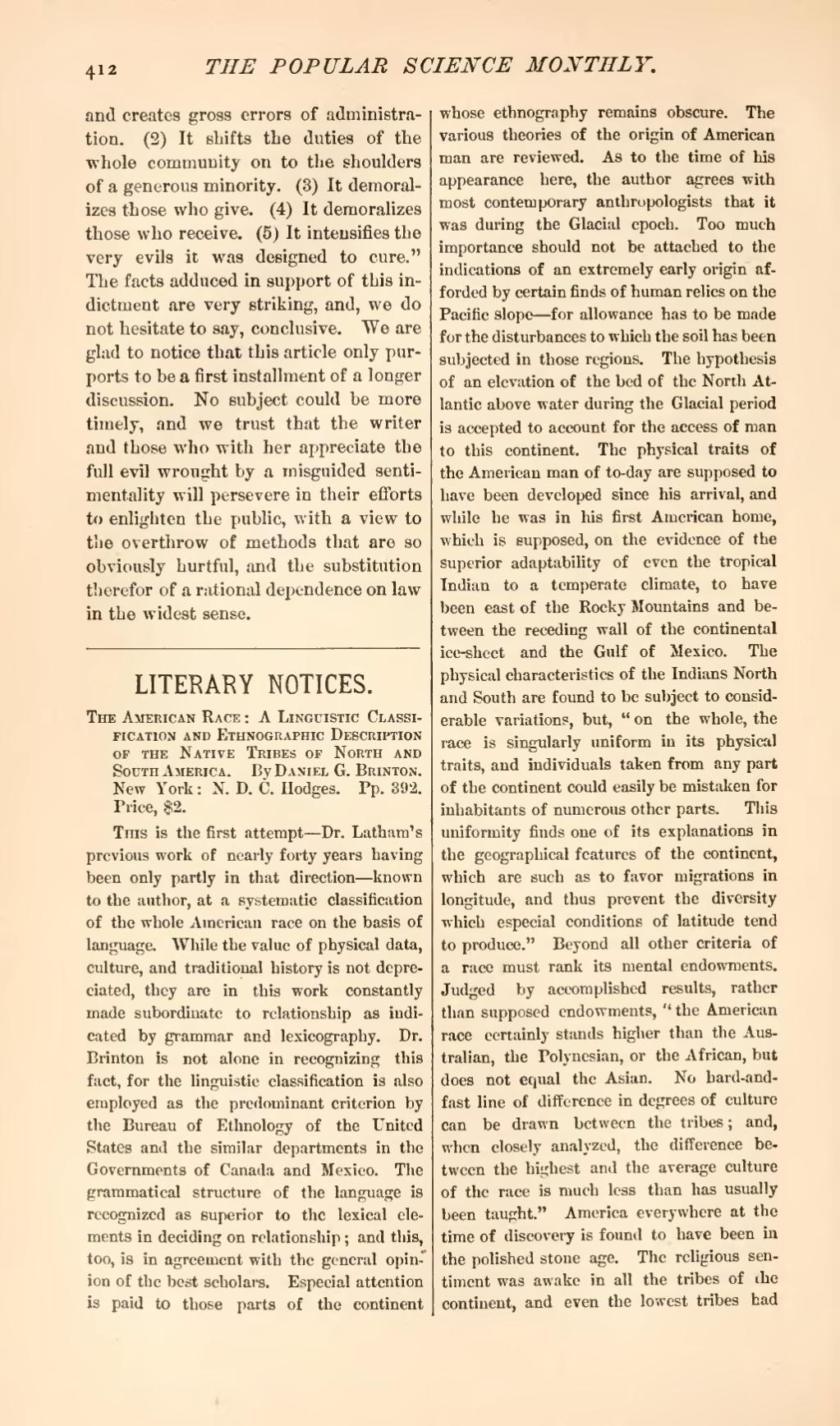and creates gross errors of administration. (2) It shifts the duties of the whole community on to the shoulders of a generous minority. (3) It demoralizes those who give. (4) It demoralizes those who receive. (5) It intensifies the very evils it was designed to cure." The facts adduced in support of this indictment are very striking, and, we do not hesitate to say, conclusive. We are glad to notice that this article only purports to be a first installment of a longer discussion. No subject could be more timely, and we trust that the writer and those who with her appreciate the full evil wrought by a misguided sentimentality will persevere in their efforts to enlighten the public, with a view to the overthrow of methods that are so obviously hurtful, and the substitution therefor of a rational dependence on law in the widest sense.
The American Race: A Linguistic Classification and Ethnographic Description of the Native Tribes of North and South America. By Daniel G. Brinton. New York: N. D. C. Hodges. Pp. 392. Price, $2.
This is the first attempt—Dr. Latham's previous work of nearly forty years having been only partly in that direction—known to the author, at a systematic classification of the whole American race on the basis of language. While the value of physical data, culture, and traditional history is not depreciated, they are in this work constantly made subordinate to relationship as indicated by grammar and lexicography. Dr. Brinton is not alone in recognizing this fact, for the linguistic classification is also employed as the predominant criterion by the Bureau of Ethnology of the United States and the similar departments in the Governments of Canada and Mexico. The grammatical structure of the language is recognized as superior to the lexical elements in deciding on relationship; and this, too, is in agreement with the general opinion of the best scholars. Especial attention is paid to those parts of the continent whose ethnography remains obscure. The various theories of the origin of American man are reviewed. As to the time of his appearance here, the author agrees with most contemporary anthropologists that it was during the Glacial epoch. Too much importance should not be attached to the indications of an extremely early origin afforded by certain finds of human relics on the Pacific slope—for allowance has to be made for the disturbances to which the soil has been subjected in those regions. The hypothesis of an elevation of the bed of the North Atlantic above water during the Glacial period is accepted to account for the access of man to this continent. The physical traits of the American man of to-day are supposed to have been developed since his arrival, and while he was in his first American home, which is supposed, on the evidence of the superior adaptability of even the tropical Indian to a temperate climate, to have been east of the Rocky Mountains and between the receding wall of the continental ice-sheet and the Gulf of Mexico. The physical characteristics of the Indians North and South are found to be subject to considerable variations, but, "on the whole, the race is singularly uniform in its physical traits, and individuals taken from any part of the continent could easily be mistaken for inhabitants of numerous other parts. This uniformity finds one of its explanations in the geographical features of the continent, which are such as to favor migrations in longitude, and thus prevent the diversity which especial conditions of latitude tend to produce." Beyond all other criteria of a race must rank its mental endowments. Judged by accomplished results, rather than supposed endowments, "the American race certainly stands higher than the Australian, the Polynesian, or the African, but does not equal the Asian. No hard-and-fast line of difference in degrees of culture can be drawn between the tribes; and, when closely analyzed, the difference between the highest and the average culture of the race is much less than has usually been taught." America everywhere at the time of discovery is found to have been in the polished stone age. The religious sentiment was awake in all the tribes of the continent, and even the lowest tribes had
